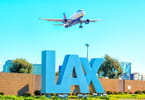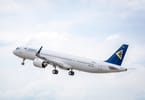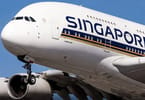In 2019, our benchmark year for pre-COVID travel, the Middle East had the lowest share of domestic air capacity, just one in five seats on offer during the calendar year was defined as an internal flight. This compares to a global average of 59% and markets such as North East Asia and North and South America where domestic activity accounted for more than three quarters of airline inventory in 2019.
For some major markets there simply isn’t any domestic air connectivity to support recovery while international travel restrictions remain.
A reliance on domestic flows is not an option for markets such as Bahrain, Kuwait, Lebanon and Qatar, while in the United Arab Emirates (UAE) domestic flights account for less than 0.1% of schedules. For airlines in markets such as Iran and Saudi Arabia it is a different story, and they can positively look to maximize activity in their strong domestic markets to bring much-needed revenue into their businesses.
In fact, the domestic recovery in Saudi Arabia is already showing positive signs, in frequency terms at least.
CAPA analysis shows that scheduled weekly domestic frequencies in the Kingdom have grown to around the 3,000 departures level. Over the first two months of 2021 that represented around a -23% decline on the same period in 2020 before COVID restrictions hit locally.
In fact, flyadeal CEO Con Korfiatis told me last month in an exclusive CAPA Live interview that the LCC itself was offering schedules with frequencies just 10% lower than this time last year. He described “ a very robust appetite for domestic travel” and the development of domestic tourism given people couldn’t travel internationally. If you haven’t viewed the interview, then you can access it on-demand via the CAPA Live platform.
While this Saudi Arabia insight shows positives in domestic markets, the pressure from international travel restrictions is hurting Middle East airlines hard. Latest IATA data for Jan-2021 shows that passenger traffic fell globally, both compared to pre-COVID levels (versus Jan-2019) and compared to the immediate month prior (Dec-2020).
Total global demand in Jan-2021 (measured in RPKs) was down -72.0% compared to Jan-2019. That was worse than the -69.7% year-over-year decline recorded in Dec-2020. Domestic demand was down -47.4% versus pre-crisis levels (Jan-2019) and the -42.9% year-on-year performance in Dec-2020. International demand in January was -85.6% below January 2019, a further drop compared to the -85.3% decline recorded in Dec-2020.
In the words of IATA’s director general Alexandre de Juniac, the data shows that “2021 is starting off worse than 2020 ended”. In the Middle East airlines saw demand plunge -82.3% in January compared to Jan-2019. This was broadly unchanged from an -82.6% demand drop in Dec-2020 versus the year ago period. Capacity fell two thirds, down -67.6%, and load factor declined 33.9 percentage points to 40.8%.
To say that 2021 has not gotten off to a good start in the Middle East, in fact the world, is an understatement. Financial prospects for the year are worsening as governments tighten travel restrictions and IATA has warned the industry will burn through USD75 to USD95 billion in cash this year, rather than turning cash positive in the fourth quarter, as previously thought.
For international flying it takes two to tango and the recovery of Middle East connectivity is reliant upon the freedom of movements from abroad.
Comparing international schedules over the first two months of 2021 with the same periods in 2019 and 2020 shows how deep the chasm indeed is. International flight capacity within and from the Middle East remained down almost two thirds, down -65.0% versus 2020 and down -63.8% versus 2019. On a country basis only Iran, Lebanon and Qatar have recovered half the capacity they had on offer during the first two months of last year.
Interestingly, while the region’s largest markets have been hit hard by international travel restrictions and subdued demand, they are actually performing better than many other major global markets. They are performing weakly, yes, but others are bleeding more heavily.
Last week, CAPA’s corporate travel arm, CTC – Corporate Travel Community completed some internal analysis of the world’s largest international country markets, comparing schedules for Feb-2021 with Feb-2019. It showed that countries in the region have risen the global rankings. Qatar has risen from being the 25th largest international market in Feb-2019 to the 7th largest in Feb-2021, Saudi Arabia rose from 25th to 13th, while United Arab Emirates rose from 6th to 2nd place.
As we see COVID-19 continues to cast a massive shadow over air travel. Take for example Kuwait.
This is a country without a domestic air network and where despite draconian steps to combat coronavirus transmission, has still struggled with high infection rates per million people. Kuwait’s initial response has received praise from the World Health Organization, but its geographical and social inequalities, and failures in urban planning, management and policy, have ultimately failed to contain the pandemic.
Cases of COVID-19 in Kuwait are now hitting new highs, over a year since its first cases were recorded and now more than 196,000 cases have been confirmed in the country, albeit fatalities have fortunately remained low. Tough travel restrictions had been in place, but these have been tightened, further impacting the country’s air carriers – Kuwait Airways, and Jazeera Airways.
Jazeera Airways in particular had been flying high ahead of COVID’s arrival. Investing in its own terminal at Kuwait International Airport, and a modern fleet of aircraft serving an expanded network, it was proving a popular option for travelers.
In Oct-2019 it even launched flights to London, ending a British Airways and Kuwait Airways duopoly Its service to London Gatwick represented a key milestone in a city market that had not seen a new entrant in over 50 years. Ahead of its arrival Kuwait Airways and British Airways had provided stable levels of capacity between Kuwait City and London, albeit the former added three additional weekly rotations in summer 2019 just prior to Jazeera entering the market.
What’s more, Jazeera’s growth was being delivered sustainably and profitably – some would say a rare achievement in the airline business. But the impact of COVID is now clear to see.
In the last few weeks, the airline has announced its 2020 results and a net loss of KWD26.4 million Kuwaiti dinar (that’s around USD87 million), an operating loss of KWD20.7 million with annual revenues declining to KWD41.4 million. In the previous year, the airline had recorded a net profit of KWD14.9 million, an operating profit of KWD14.2 million and generated revenues in excess of KWD103 million.
Meanwhile, Kuwait Airways marked an important milestone last year, not just in Kuwait, but across the world, receiving the first A330-800s from Airbus… in fact two of them. The aircraft are part of an order for eight of the type, which incorporates latest-generation Rolls-Royce Trent 7000 engines, along with multiple aerodynamic improvements to provide a more efficient aircraft than its older versions.
In Kuwait Airways’ configuration the A330-800neo accommodates 235 passengers, featuring 32 fully-flat beds in business class and 203 seats in Economy while offering a large cargo hold capable of accommodating the generous passenger baggage allowances on offer in this part of the world. The use of Collins Aerospace Super Diamond seat in the business class cabin is nothing innovative – the seat is already offered by a host of other airlines – but represents a notable product upgrade for the carrier. In fact, it represents an enhanced offering than that fitted on its 777 fleet that serve the airline’s flagship routes.






















